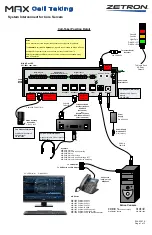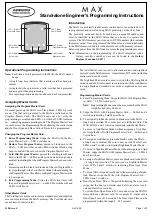
Micro-Master Touch User Guide
23
© 2014 Toro Australia Pty Ltd
Ver 1.2, June 2014
Loosen the right hand cable gland nut and insert the plug pack wires.
Separate the plug pack wire into the two conductors and strip 5mm of insulation from each wire.
Connect the wire with the white stripe to the Connector Block Pwr position labelled ”+” and connect
the other wire to the Connector Block Pwr position labelled “-“.
Plug the RM01 Plug Pack into a 240V mains wall socket and switch on. Using a voltmeter on at least
a 20V DC range, confirm that a nominal 12Vdc is present across the Connector Block Pwr position.
Tighten the cable gland nut.
Connecting Valve Wire, All Radio-Master for Touch Modules
The RMT Field Module is designed for 2 wire solenoid operation; 12V is momentarily applied across
the connector block positions labelled “L” and “U” for each valve when commanded on or off by a
Micro-Master Touch controller.
Loosen an appropriate cable gland nut and insert the solenoid wires.
Strip 5mm of insulation from the solenoid wires.
Connect the solenoid latch wire to the Connector Block positions marked “L” for the appropriate valve
number. For a Bermad S985 solenoid the Latch Wire is White. For a Baccara 2 wire latching solenoid
the Latch wire is Green.
Connect the solenoid unlatch wire to the Connector Block positions marked “U” for the appropriate
valve number as shown in the previous picture. For a Bermad S985 solenoid the Unlatch Wire is
Red. The Black wire is unused. For a Baccara 2 wire latching solenoid the Unlatch wire is Black.
Tighten the cable gland nut.
To prevent insect infestation, any gaps should be eliminated, by tightening the cable glands securely,
or filling the gaps with a suitable all weather sealant.
Connecting Digital Sensors, RMT440D Field Modules
The RMT440D is designed to accept four digital pulse sensors. The RMT440D inputs accept voltage
free contact closures. The sensor wiring positions are on the left hand side connectors and marked 1
to 4 with + and – positions. The – position goes to ground, and the + position to the sensor output as
shown in Figure 14.
RMT440D Inputs
1 2 3 4
+ - + - + - + -
Figure 14 - RMT440D Connection Schematic
















































